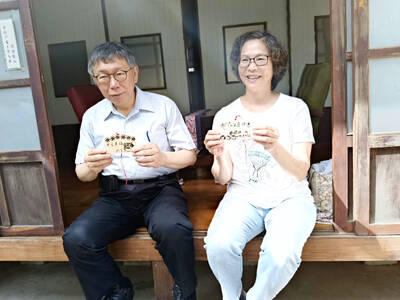Organizing Chinese characters into a dictionary format is not easy. Radicals, stroke counts, phonetic sounds and of course the definitions themselves all compete for the right to bring order, and the unlucky recipient looking for a word or definition may need to be prepared to traipse between books looking for a satisfactory result. As a result, portable electronic dictionaries have become enormously popular and the available range is huge.
However, most are useless for people learning Chinese as a foreign language, since they are tuned for local learners. Luckily, the industry is increasingly taking note of this growing niche, and this article takes a look at two dictionary products that work as learning or reference aids.
XCome Dictionary
Pre-installed on Asus Eee PC
NT$9,500 to NT$20,000, depending on configuration
www.xcome.com
Well-specified dedicated portable
electronic dictionaries are not cheap. Instant Technology’s (快譯通) MD6700 runs in at just under NT$10,000, and for more or less the same price Asus will sell you its Eee PC. “That computer with the funny name” is a full-fledged PC that wirelessly connects to the Internet,
communicates with people with its
integrated Web-cam and mic, and
provides you with professional-grade Microsoft-style software. Into this mix comes XCome’s dictionary, which in Taiwan ships ready to solve your
Chinese and English language problems.
XCome was invited by Asus to create dictionary and language reference software that comes pre-installed on all Linux versions of the Eee PC. As a study aid, it fits pretty well into the armory, sized as it is like a hefty paperback book. The 7-inch screen is small on the basic version and the keyboard a little pokey for those with sausage fingers, but that is what you get when you buy a small computer. Crucially, the unpainted plastic on the cheaper versions and tough solid-state disk drive encourage you to take it anywhere and treat it like a schoolbook.
Opening the dictionary program is simple, though it is unexpectedly located in the “Work” tab of the operating system menu, rather than “Learn.” The user interface is clear, and looking up a word is as straightforward as typing it into the search box. One of the software’s best features is the ability to do “instant lookup” when working in other programs — including while instant messaging, browsing the Internet or working in the included Sun OpenOffice — a suite of free software that aims to challenge Microsoft Office. As you move your mouse over a word, a mini-definition pops up, and you can then jump into the full dictionary to explore more.
The dictionary works with both traditional and simplified Chinese characters, and in most cases the English definition includes a “speak” function, where the word is read out loud, although unfortunately the same luxury is not afforded to the Chinese definition. The product is clearly more suited to learners of English, rather than of Chinese, although it is hard to blame XCome, as Asus specifies which dictionaries should be included and it would be an easy step to improve this.
This impression is reinforced when attempting to type in Chinese. The EeePC software allows typing of traditional characters in Zhuyin Fuhao (注音符號, or Bopomofo), but sadly restricts Hanyu Pinyin (漢語拼音) input to simplified characters.
Overall, the EeePC is a very impressive tool, but one that is tailored more for local learners of English, rather than for beginner-to-intermediate learners of Chinese.
Dr Eye — Han Easy 1.0
Microsoft Windows
US$80
www.dreye.com
Dr Eye, provider of the popular dictionary and translation program for Microsoft Windows, is probably also to blame for much of the poor English translation in Taiwan and over-enthusiastic thesaurus use. No matter — Dr Eye is now launching software aimed at learners of Chinese, so we can make the same mistakes too.
On the surface, it seems like Han Easy is a simple re-skinning of the standard Dr Eye software. The attempt at making the program appear Chinese by styling the interface like ancient scrolls of text — complete with fluted edges and antique buttons — is misguided, but you can’t fault the enthusiasm.
However, the translations impress with their examples set in context, spoken output — and even animated illustrations of the strokes. Tourist attractions and local culinary specialties are proudly introduced, along with basic phrases for travel and survival. It’s clear that Dr Eye is putting considerable effort into tuning this for “foreign” learners of Chinese. Guidebook and dictionary aside, instant translations are available when browsing the Internet or using instant messaging, as on the EeePC.
It seems as if that in trying to work out what foreigners need when learning Chinese, the target audience has become rather blurred, as it includes tourists, students and experts. One also might have to doubt the reality of pulling out a Windows laptop in a busy restaurant to order food. With feedback and time, the software will certainly improve and become less cartoon-like and eager to please. If you want some software for beginners, it is certainly worth a look, but otherwise the powerhouse of Wenlin is more suited to scholars and professional users.
There is more than one way to build a Chinese dictionary. By the same token, there is also more than one type of user. When selecting a dictionary, make sure you ask yourself what you need and choose accordingly.

Climate change, political headwinds and diverging market dynamics around the world have pushed coffee prices to fresh records, jacking up the cost of your everyday brew or a barista’s signature macchiato. While the current hot streak may calm down in the coming months, experts and industry insiders expect volatility will remain the watchword, giving little visibility for producers — two-thirds of whom farm parcels of less than one hectare. METEORIC RISE The price of arabica beans listed in New York surged by 90 percent last year, smashing on Dec. 10 a record dating from 1977 — US$3.48 per pound. Robusta prices have

A dozen excited 10-year-olds are bouncing in their chairs. The small classroom’s walls are lined with racks of wetsuits and water equipment, and decorated with posters of turtles. But the students’ eyes are trained on their teacher, Tseng Ching-ming, describing the currents and sea conditions at nearby Banana Bay, where they’ll soon be going. “Today you have one mission: to take off your equipment and float in the water,” he says. Some of the kids grin, nervously. They don’t know it, but the students from Kenting-Eluan elementary school on Taiwan’s southernmost point, are rare among their peers and predecessors. Despite most of

The resignation of Taiwan People’s Party (TPP) co-founder Ko Wen-je (柯文哲) as party chair on Jan. 1 has led to an interesting battle between two leading party figures, Huang Kuo-chang (黃國昌) and Tsai Pi-ru (蔡壁如). For years the party has been a one-man show, but with Ko being held incommunicado while on trial for corruption, the new chair’s leadership could be make or break for the young party. Not only are the two very different in style, their backgrounds are very different. Tsai is a co-founder of the TPP and has been with Ko from the very beginning. Huang has

A few years ago, getting a visa to visit China was a “ball ache,” says Kate Murray. The Australian was going for a four-day trade show, but the visa required a formal invitation from the organizers and what felt like “a thousand forms.” “They wanted so many details about your life and personal life,” she tells the Guardian. “The paperwork was bonkers.” But were she to go back again now, Murray could just jump on the plane. Australians are among citizens of almost 40 countries for which China now waives visas for business, tourism or family visits for up to four weeks. It’s